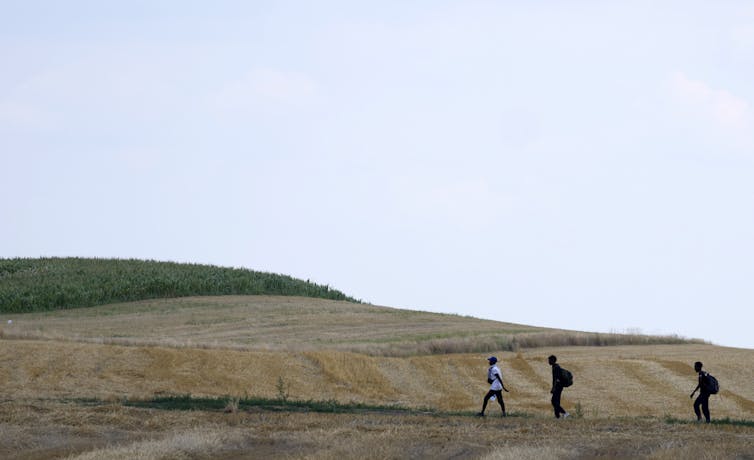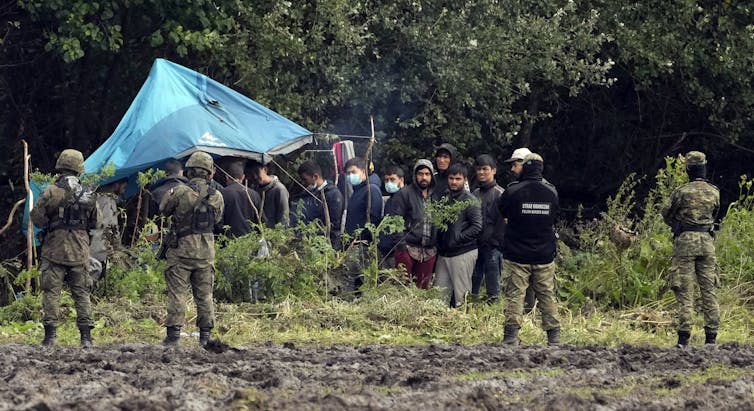Raluca Bejan, Assistant Professor of Social Work, Dalhousie University and Salim Nabi, Research assistant, Migration, Dalhousie University.
In 2019, when we were doing research on the integration of refugees in Romania, the topic seemed irrelevant for Romanians and other eastern Europeans. During an interview we conducted, one member of Romanian parliament stated:
“We don’t see them. We don’t meet them on the street, they don’t exist.”
Two years later, and eastern European nations that aren’t in the European Union — Serbia, Bosnia, Belarus and Turkey — are being accused of using migrants as pawns against the EU member states of Romania, Poland, Greece and Croatia.
Romania is in the news for becoming an entry hotspot for migrants on the Balkan route, the so-called “poor people’s route to Europe,” and for violently pushing asylum-seekers back to Serbia. Similar stories are unfolding in Croatia, with hundreds of illegal pushbacks at the border with Bosnia.

In Poland, police have used tear gas and water cannons to deter asylum-seekers from crossing the Belarusian-Polish border.
Similar to how Turkey opened its borders to EU member Greece in March 2020 to allow Syrian refugees to make their way to western Europe, Belarus has been using migrants as leverage against Europe. The Turks did so to force NATO, especially Europe, to back their position in the Syrian war following the 2020 conflict between Syrian government forces and Turkish-backed rebels in Idlib.
Now Belarus is diverting public attention away from its own human rights violations. Poland says Belarus has lured hundreds of Middle Eastern migrants to the country for the purpose of sending them across the Polish border to retaliate against economic sanctions imposed by the EU earlier this year.
Sharing responsibility in the EU is impossible
In 2015, the European Commission adopted two procedural decisions to relocate, on a quota agreement, 160,000 people in need of international protection from the over-burdened front-line nations of Italy and Greece to the least affected member states.
Poland refused to participate.
That’s despite a legal requirement as part of the EU to relocate 6,182 migrants. It’s also despite the EU’s 2017 sanctions against Poland, the Czech Republic and Hungary for failing to comply with the requirements.

It would be easy to blame eastern European racism and suggest the region is xenophobic and culturally backward. Yet such simplistic reasoning would overlook the disparities between the EU and its western, more developed nations compared to their eastern European counterparts.
The EU’s Schengen agreement, which carves out a region within the union with no internal border controls, is available to western EU nations but not their eastern neighbours, as is the euro currency. That’s already created “a union of different speeds.”
Member states have different positions in EU, not only in terms of geography, economics and demographics, but also in relation to political power and migrant integration initiatives.
For instance, the EU-wide relocation strategy for transferring migrants rescued at sea was developed on the basis that all EU members are equal and should therefore share responsibility for refugees.
But research has shown that eastern European nations are not on equal footing when it comes to asylum. The former communist states lack effective refugee integration strategies, like national administrative structures for managing migration.
They have weak systems of providing refugees with adequate accommodation, meals or pocket money — benefits that have been present for decades in the western part of the continent.
Inequities among EU nations
How fair is it to equally share responsibility given the economic, social and political differences among the EU’s member states? The wealthier nations of western Europe — Sweden, Finland and France, for example — have higher capacity to welcome asylum-seekers due to well-established systems of migration management.
Migrants don’t want to settle in eastern member states like Poland, Croatia or Romania because their socio-economic conditions and refugee integration systems leave a lot to be desired. As stated by one of the Romanian bureaucrats we interviewed in 2019:
“We transferred a total of 728 people, because that’s how many Greece and Italy sent us. There were foreigners that refused … generally speaking, they were refusing the eastern countries. All of them wanted the western European states.”
The Dublin Agreement was adopted in 2003 to determine which EU member states were responsible for accepting asylum-seekers. It constitutes the backbone of the EU’s shared responsibility on refugee issues, tying asylum claims to where migrants enter the EU.
That protects the western, wealthiest nations from dealing with high migrant flows, and allows the EU to hand over responsibility for asylum-seekers to eastern and southeastern European countries. That’s why the Greek and the Italian asylum-processing systems were tapped out in 2015 at the peak wave of refugee entries.

Yet isn’t the EU to blame for leaving southern Europe on its own to deal with crisis, which could have been easily avoided by allowing people to freely move within the entire EU?
Consider the beginning of the refugee crisis. It emerged from Libya, Afghanistan, Iraq and Syria. Whether we look at the colonial maps drawn by western European empires or at the recent NATO-backed foreign policies pursued by an EU servile to the United States, foreign involvement in the Middle East has led to instabilities in the region.
As NATO members, western European states have been regularly involved in fuelling the refugee crisis. It’s not surprising that non-EU countries like Turkey or Belarus have attempted to reap some regional benefits by using refugees as pawns against the EU.
EU efforts to deter migrants
Belarusian President Alexander Lukashenko’s attempts to do so merely represent half of the story. The EU has also done its best to deter people from entering its territory. In 2016, the EU signed a deal with Turkey that specified that in return for six billion euros and the promise of waiving visa requirements for Turkish nationals, Turkey would take in migrants arriving on the Greek islands.

In other words, the EU has been paying Turkey for five years to take in migrants.
With the arrival of refugees in 2015, the EU found itself at odds with its liberal claims of human rights, sanctity of life and a globalized open world. Suddenly, the borderless world imagined under globalism — particularly free movement within the EU — was put on hold.
The wealthy European nations have since left the peripheral states, and their emerging right-wing governments, on the front lines, bearing the blame for violently pushing back migrants and for inhumane conditions at reception sites.

The EU is attempting to position itself as a beacon of liberalism and human rights as it exempts itself from political responsibility for migrants desperately seeking better lives — all while condemning their brutal determent at the continent’s periphery. It’s also trying to portray eastern European countries as racist villains infringing upon the human rights of refugees.
But it’s the EU itself that’s the real villain in the eastern European migrant crisis.![]()
This article is republished from The Conversation under a Creative Commons license. Read the original article.
Comments
comments powered by Disqus

